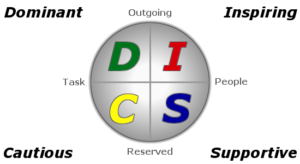An Overview Of Middle Management Leadership Styles
In 2018, there was a great article in Inc. titled “Why Finding A Great Boss Is More Important Than Finding The Perfect Job.” We couldn’t agree more with the title. The statement then invites the question “what makes a great boss?” As it turns out, there are numerous middle management leadership styles, depending on one’s primary mode of engagement in the workplace. At the same time, no matter one’s primary style, great leaders typically share a single quality in common: versatility.
Before we explore the versatility that great leaders share, let’s introduce the framework for which we assess different styles of leadership in the workplace – the time-honored DISC model.
Introducing The DISC Model
The DISC model is derived from the work of Harvard psychologist Dr. William Moulton Marston in the 1920’s. He developed a theory that people develop a self-concept based on one of four types – Dominant, Inspiring, Cautious or Supportive.

Keep in mind that the DISC model is just that – a model. It is not to be taken as an absolute indicator of a person’s personality profile, but rather a framework expressing primary styles of behavior in a work setting. In our discussion here, we are focusing on extreme versions of these behavioral traits in order to clearly differentiate them from the other styles. In reality, while we all have a primary DISC style, we share characteristics from each of the DISC quadrants.
Outgoing vs Reserved
The X-Axis of the matrix indicates an individual’s tendency in terms of high activity or low activity (Moulton called it the “motor drive.”) The individuals who test above the line share a common trait of being outgoing and fast-paced in their activity. They prefer to be in the middle of the action, driving toward goals and accomplishing projects aggressively.

North of the line, the degree to which a person is outgoing is a matter of their proximity to the center. Those farthest from it are the most fast-paced, and those closer to the line are less so.
South of the line, people are more reserved, deliberate and slower-paced. They prefer to consider things carefully and thoroughly before making decisions and undertaking projects. As before, the degree to which a person is reserved is expressed in how far they test from the center line, with those closer to the bottom being more reserved than those closer to the center line.
Task-Oriented vs People-Oriented
The Y-Axis of the quadrant indicates an individual’s tendency in terms of their dominant priority – tasks or human relationships (expressed by Moulton as the “priority drive.”) People left of the line prioritize the accomplishment of tasks, while people right of the line prioritize relationships with their peers.

As before, the degree to which a person values tasks or human relationships is a matter of their distance in either direction from the vertical line running through the center of the matrix.
The Different Types Of DISC Managers
The Outgoing Types: The Senior VP of Operations and the Marketing Director
Above the X-Axis are the outgoing styles of the Dominant and Influential Managers. For example, let’s think of them as an old-school SVP Operations and a Marketing Director.
The “Dominant” SVP is outgoing and inclined toward action like the Marketing Director, but differs fundamentally by being positioned to the left of the Y-Axis priority line. This individual tends to value things or tasks over human relationships. The signature management style of this individual is command and control. Orders get issued, and the rank and file are expected to comply.
This individual at the outset has little patience for mistakes or issues relating to human error. They can often struggle to take the time to communicate effectively, and rather than taking time to clarify, may prefer to charge ahead with the project at hand. On the other hand, they are effective at getting things done, and as long as they do, they don’t often care much about how it gets done.
The “Influential” Marketing Director on the other hand, while high-energy like their Dominant SVP Operations counterpart, sits to the right of the Y-Axis priority line and therefore prizes human relationships over tasks. This individual is concerned with inspiring and rallying people around a creative vision, and making sure that the project is engaging and absolutely brilliant.
This individual also cares much more than their dominant counterpart about what other people think of them. When shut down or told no, the “Influential” Manager can often take it personally and be frustrated with whomever they perceive as curtailing their creativity and vision.
The Reserved Types: The Finance Manager and The HR Manager
Below the X-Axis are the reserved styles of the Cautious and the Supportive. For example purposes, let’s think of them as a Finance Manager and an HR Manager.
To the left of the Y-Axis priority line sits the “Cautious” Finance Manager, content and happy in their office generating reports and working with numbers. This person values order, logic and following the rules so that not a single detail is overlooked. They deal with people when they have to, but prefer to minimize time spent in meetings and networking events so that they can focus on doing their job without distractions or interruptions.
Across the hall from the Finance Manager is the other reserved style, the “Supportive” HR Manager, who sits to the right of the Y-Axis priority line. This person, like the Finance Manager, also prefers to remain in the background of the organizational community. The difference lies in their preference for human relationships over tasks.
This person spends their days thinking about the well-being of their co-workers and the larger workplace community. He or she devises training programs in communications, diversity equity and inclusiveness, and is making plans for the holiday party. This is the person who also makes sure to remember everyone’s birthday, and to encourage leadership teams to publicly acknowledge people for a job well-done, or select an employee of the month.
Each Style Is Effective In Its Favored Context
There is no one style better than the other. In fact, we might be able to conclude that since every workplace, team or classroom has individuals fitting each profile, that each of these different styles are meant to complement each other so that the group has the best odds at succeeding at their given task and thriving in the marketplace.
As far as the individual is concerned, a person’s dominant style is effective within a certain context… but what if that context changes?
For example, the Senior VP drives a project to completion, under budget and under deadline… but three employees submit their 2-weeks’ notice shortly afterward.
Or maybe in a single quarter the HR Manager negotiates funding for several communication workshops, persuades leadership to install an attractive outdoor lunch patio, and advocates for the adoption of a 35-hour workweek for companywide emotional well-being… but when the quarterly numbers come in (from the Finance Manager’s office) profits appear to have begun a downward trend.
Each style excels at those activities that fall within its own priorities… but how does a leader ensure success across multiple contexts, including those contexts that lie beyond the scope of their primary behavioral priorities?
The key is versatility, or the ability to inhabit any quadrant of the DISC matrix according to the situation at hand.
Developing Behavioral Versatility Is Key To High Performance Leadership
At the outset of my career, I was an accountant. Like most accountants, I was firmly established on the lower left side of the quadrant – reserved and task-oriented (the Finance Manager, remember?) However, as I progressed in my career, it became evident that I needed to begin traveling to the right side of the matrix – in the direction of human relationships.
An introvert at heart, I sometimes found the act of coming out of my shell and increasing my engagement with people to be challenging. In the long run, it proved to be my capacity for developing relationships and empowering the people around me that enabled me to grow in my career, and successfully take on greater responsibilities. In other words, relationship building was much more crucial to my professional development than number-crunching alone.
How does a person develop the ability to inhabit different areas of the matrix according to the situation at hand?
It is necessary to develop an awareness of other people’s styles, and learn to communicate in terms they (a) understand, and (b) value most.
There is a time to issue brief, direct orders – and there are the working styles that prefer to receive their orders that way. There is also a time to take a moment in the middle of the busy day to check in with someone who seems a bit preoccupied and not quite him or herself the past week.
To clarify, versatility does not mean being calculating or disingenuous, and shifting one’s values or truth according to the needs of the moment. If we could sum versatility and its importance to high performance leadership in a single phrase, it would be this:
Don’t just manage — become a coaching manager.
A great coach has their own behavioral style, but has cultivated the versatility to inhabit every style in order to empower their people and get the best out of them.
The Coach sits at the very center of the matrix. Like a skilled athlete or martial artist, the Coach can respond to the situation at hand by accessing any part of the matrix they wish, and then reset to the center – poised to respond in the most effective way to the next situation.
Looking back on my own journey, I would offer this suggestion when embarking on the journey toward becoming a coaching manager:
In the middle of your next team meeting, when the high-energy folks are throwing ideas at the wall and debating vigorously with each other… take a moment out to ask the reserved people (the introverts) what they think.
Or, encourage the dominant or influential types to listen to their cautious and supportive counterparts, on the basis of the fact that the more perspectives that can be brought to a given challenge, the greater the likelihood of generating a great solution.
Finally, the DISC model, while not absolute, is a great starting place for engaging your people and teaching them a framework within which they can develop improved communication, collaboration, and insight.
If implementing a DISC assessment among your work team sounds like it would be of interest, please get in touch with us at Hallett Leadership. We would be happy to help.





